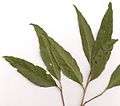Eucalyptus expressa
| Wollemi Stringybark | |
|---|---|
 | |
| gumnuts of the Wollemi Stringybark, Yengo National Park, Australia | |
| Scientific classification | |
| Kingdom: | Plantae |
| (unranked): | Angiosperms |
| (unranked): | Eudicots |
| (unranked): | Rosids |
| Order: | Myrtales |
| Family: | Myrtaceae |
| Genus: | Eucalyptus |
| Species: | E. expressa |
| Binomial name | |
| Eucalyptus expressa S.A.J.Bell & D.Nicolle | |
| Synonyms | |
|
Eucalyptus sp. aff. eugenioides (Bees Nest Ridge) | |
Eucalypus expressa, the Wollemi Stringybark, is a recently discovered Australian tree species.[1][2][3] It is a tall forest tree from at least seven populations in sheltered gullies in the sandstone ranges north-west of Sydney. A ROTAP rarity rating of 2KC has been proposed for this species.[4] Usually seen between 20 and 45 metres (66 and 148 ft) tall, it is most closely related to Eucalyptus eugenioides, and was previously known as E. sp. aff. eugenioides (Bees Nest Ridge).[5]
The specific epithet expressa is from the Latin expressus, which means “prominent and clearly exhibited”. This refers to the long, narrow and prominently external valves of the gumnuts. Another interesting feature of this plant is the somewhat scalloped or irregularly toothed leaf edges. It occurs in and near Wollemi National Park and Yengo National Park.[5] The original specimen was collected beside the Putty Road.
The trunk is cylindrical and tall, grey brown, with reddish stringybark tinges. Adult leaves are thin and broad-lanceolate in shape, 8 to 16 cm (3.1 to 6.3 in) long by 1.8 to 4.8 cm (0.71 to 1.89 in) wide on a 8 mm (0.31 in) leaf stem. Uneven at the base and with an intramarginal leaf vein. The veins at arise at an angle of 30 to 40 degrees to the midrib. The leaf is the same colour green above as below, and the leaf margins are scalloped. The gumnuts measure 7 mm × 5 mm (0.28 in × 0.20 in) on a 2 mm (0.079 in) stem. Truncate globose or hemispherical, they have 3 or occasionally 4 valves, extending 3 to 7 mm (0.12 to 0.28 in) beyond the rim of the gumnut. There is little information yet available about the flowering of this species.[6]
See also
Photos
-

wavy edged leaves
-

Wollemi Stringybark measured at 42 metres tall
-

stringybark trunk
-
one of the describing scientists, Dean Nicolle and an associate species of the Wollemi Stringybark, Mountain Blue Gum
References
- ↑ Bell, S.A.J. (2008) Rare or threatened vascular plant species of Wollemi National Park, central eastern New South Wales. Cunninghamia 10(3): 331-371.
- ↑ Binns, D. (1996) Flora Survey, Morisset Forestry District, Central Region, New South Wales. Forest Resource Series 35. State Forests of New South Wales, Pennant Hills.
- ↑ "Eucalyptus expressa". Australian Plant Name Index (APNI), IBIS database. Centre for Plant Biodiversity Research, Australian Government.
- ↑ Poorly known species suspected of being at risk, occurring in a range of less than 100 km (62 mi), at least partially conserved in a national park
- 1 2 "Tim Hager & Doug Benson - The Eucalypts of the Greater Blue Mountains World Heritage Area: distribution, classification and habitats of the species of Eucalyptus, Angophora and Corymbia (family Myrtaceae) recorded in its eight conservation reserves" (PDF).
- ↑ Klaphake, V. (2010) Eucalyptus of the Sydney Region. Second edition